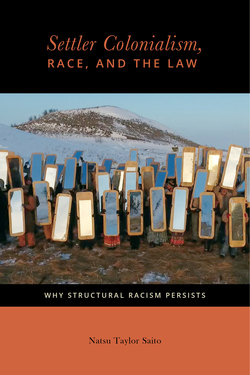Читать книгу Settler Colonialism, Race, and the Law - Natsu Taylor Saito - Страница 14
Moving Forward
ОглавлениеWhat will it take to actually dismantle the racial hierarchy in evidence throughout American society? It has been 150 years since Congress amended the Constitution to guarantee all persons equal protection under law, and a half century since the Civil Rights and Voting Rights Acts were passed. In the interim we have had Democratic and Republican administrations, and our first Black president. The rhetoric of race has shifted considerably over this period, but de facto segregation, disproportionate incarceration rates, and racial disparities in wealth and income, as well as in access to healthcare, housing, and education, persist. State actors are taking full advantage of the newly expanded opportunities to restrict social welfare programs; to roll back protections against discrimination on the basis of race, gender, sexuality, religion, national origin, or immigration status; to minimize the exercise of Indigenous rights; and to assign natural resources to corporations. As a result, we have every reason to expect that racial disparities will continue to grow.
A lot of people have taken to the streets since Donald Trump’s election. In most cases, however, it is not evident that they have plans for constructive engagement that go beyond expressing their dissatisfaction with particular governmental actions, actors, or policies. We find ourselves in an era of renewed energy and activism, but we also face intensified versions of all the factors that neutralized the movements of the 1960s and 1970s: the rollbacks of programs supporting access to basic social goods and services, a general expansion of police power, and intensified political repression in the form of counterinsurgency as well as counterintelligence operations. In response to the growing number of protest actions, federal, state, and local officials are seeking heightened criminal penalties for protesters and criminalizing many forms of resistance.
Thus, for example, in Washington, DC, in January 2017, following massive inauguration protests, more than two hundred protesters faced riot-related charges that could have resulted in up to eighty years’ imprisonment.125 Ultimately most of the charges were dropped, but the government had served notice that virtually any form of political protest will, henceforth, trigger a draconian response.126 Even before Trump became president, many state legislators were targeting those who contest oil pipelines or protest police killings. According to the Intercept, as of January 2017, legislation had been introduced that “would allow motorists to run over and kill any protester obstructing a highway as long as a driver does so accidentally,” “allow prosecutors to seek a full year of jail time for protesters blocking a highway,” “reclassify as a felony civil disobedience protests that are deemed ‘economic terrorism,’” and “make it easier for businesses to sue individual protestors for their actions.”127 State legislatures have considered making protesters pay for policing, and debated “Blue Lives Matter” bills that characterize attacks on law enforcement as hate crimes.128 While most of these proposals have not yet been passed, it is clear that the personal risks associated with political engagement are increasing.
Can creative and energized responses to political, economic, and sociocultural repression be maintained under these conditions? What is needed for popular activism to transform not just the discourse about race and social justice but the structures that perpetuate inequality? What kinds of options, legal and political, might truly be effective? For most of the past half century, we have relied on the Constitution’s guarantees of due process and equal protection to rectify racial injustices. But this strategy has proven inadequate, for it does not address the underlying dynamics of power.129 To effectively challenge the institutionalization of racial hierarchy, violence, and exploitation in this country, we will need strategies grounded in conceptual frameworks capable of explaining the underlying functions of racialization and the mechanisms through which race-based privilege and subordination are created and maintained.
A first step toward developing such frameworks involves overcoming the “false consciousness” under which we have been operating.130 If, as Dorothy Roberts observed, this system “brilliantly serves its intended purposes,”131 meaningful change will require forgoing the comfort of a narrative that promises constant if gradual “progress.” Instead, we will need narratives that incorporate the histories and lived realities of peoples of color in this country, for without these, our ability to envision and construct alternative futures will be hopelessly constrained.
